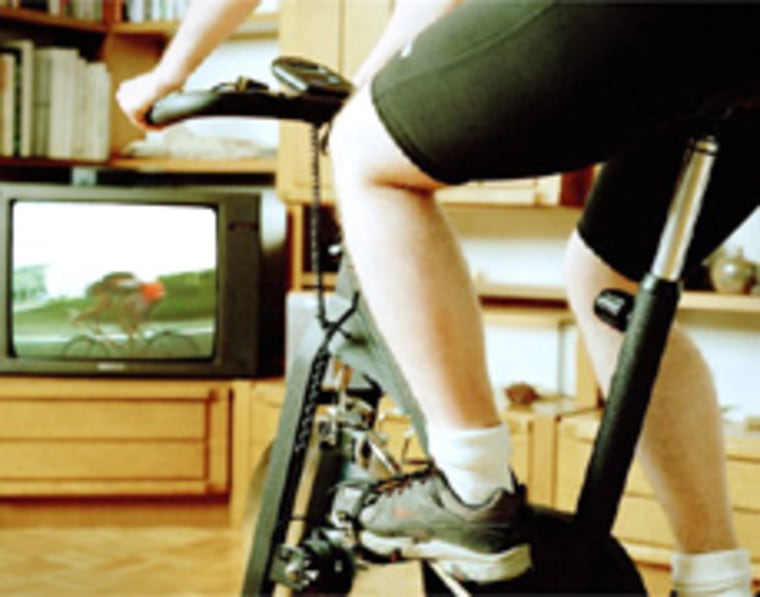For people with hectic schedules, a home gym can be the solution to never having enough time to go to the health club. In fact, more and more Americans are going this route. Sales of exercise equipment for the home have doubled over the last decade, and often surge this time of year as people make their New Year's resolutions to get fit. But if you're in the market for fitness gear, sorting through the myriad machines can be a workout in itself.
Retail sales of home exercise equipment, including cardiovascular and weight machines, free weights and other items like fitness videos, totaled $4.3 billion last year, up from $2.9 billion in 1997 and $2 billion in 1992, according to the National Sporting Goods Association. "It's really picked up in the last five years," says Larry Weindruch, a spokesperson for the group.
People whose busy lifestyles make exercising at home a convenient option are fueling the trend, he says, along with aging baby boomers hoping to fight back the hands of time. Working out at home can also be cheaper than joining a health club year after year.
The most popular piece of equipment, by far, is the treadmill, which accounted for $2.5 billion in sales last year, Weindruch notes.
But there's no single machine that's best for everyone, experts say.
If you're shopping for exercise equipment, your first task is to determine which activities appeal to you most. Hate to bike? Maybe a stair climber or elliptical trainer would be a better choice. Don't like weight machines? Opt for free weights or resistance tubing.
"The single most important consideration before buying home fitness equipment is to choose equipment that you'll like to use," says Michael Bracko, an exercise physiologist in Calgary, Alberta, Canada, and a spokesperson for the American College of Sports Medicine.
"Otherwise," he says, "it's a very expensive clothes hanger."
Once you've identified which activities you'd like to engage in at home, do some research. Independent product reviews in publications like Consumer Reports and Runner's World can help you get an idea for the range of products and features available and which ones get the best scores, experts say.
Work up a sweat
But ultimately, you'll need to do some legwork -- even work up a sweat -- to find which equipment is best for you.
Bracko recommends visiting three to five fitness stores and spending an hour or two in each one. Ask lots of questions about the various products and then try them out. Come wearing sneakers and sweats so you can work out with a machine for 10 minutes or so.
"Make sure it's a good fit," says Barbara Bushman, an associate professor of health, physical education and recreation at Southwest Missouri State University in Springfield.
A product may have an excellent rating but if you don't like how the handles feel or the readout works or the way the belt moves or the weights clang together, keep looking.
And if you're planning to share the equipment with other family members, make sure they like the product as well and that it's adjustable to their body types, notes Bracko. Weight machines that work well for a 6-foot-2-inch man, for instance, may not always suit a 5-foot-3-inch woman.
Take careful note of the equipment's workmanship and safety features. Is it sturdy? Do the cables, levers or pedals operate smoothly? Is it easy to start? (And if it's a treadmill, is there an emergency stop button and is the belt long enough for your stride?) Is the display easy to read and does it provide you with the information you want (such as minutes and intensity)? Is the seat comfortable? Can you adjust the difficulty of the workout as your fitness level improves? If you like to interval train on a bike or stair climber, does the machine offer such programming?
The pricier, the better?
To some extent, you get what you pay for in exercise equipment, Bushman says. But beware all the bells and whistles. Expensive high-end models may have features like fancy electronic displays that you don't need.
Factor in how you'll use the product, she says. If you're planning to walk on your treadmill a few times a week, a less expensive model will probably suffice. But runners who will log several miles each day on the machine will likely need a pricier model that can stand up to the use.
Overall, though, exercise equipment is better than ever, says Bracko, who has tested dozens of machines. Moderately priced or even economy models also can be good, he says.
One low-cost option is to search for good used equipment, preferably with a warranty. For bikers, another way to save money is to buy a stand for their road bike, so they can use it indoors, too.
Before purchasing any equipment, though, make sure it will fit in your home. This may seem obvious, but a machine may appear a lot smaller in the store than your bedroom. All-in-one weight machines can take up a lot of room.
And it's not only floor space you need to be concerned with. If you're buying a treadmill, for instance, you'll also need to make sure ceilings are high enough to accommodate the tallest family member on the machine at a steep incline, if that's how it will be used.
Also inquire with the sales rep about warranties -- the longer the better -- and delivery and set-up.
By spending some time researching and testing exercise equipment, you should be more likely to get quality products that best suit your needs -- and, hopefully, won't wind up holding your dry cleaning in a few months.
